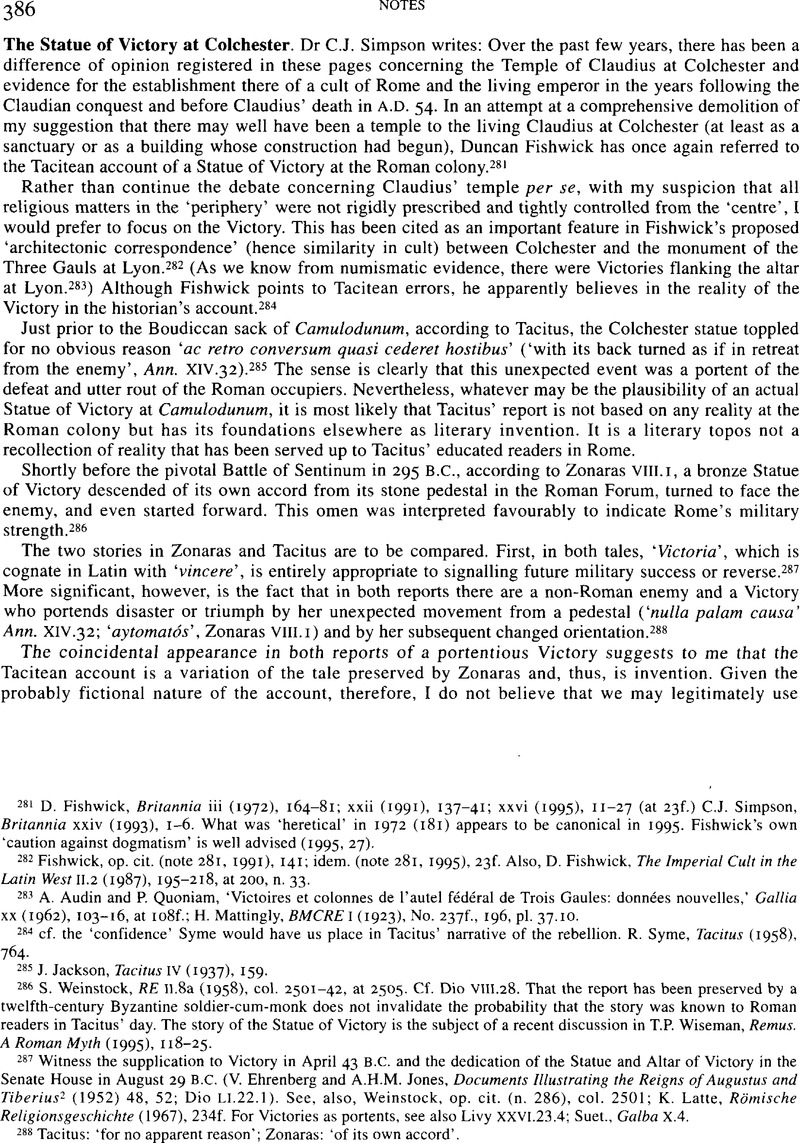Published online by Cambridge University Press: 09 November 2011

281 Fishwick, D., Britannia iii (1972), 164–81CrossRefGoogle Scholar; xxii (1991), 137–41; xxvi (1995), 11–27 (at 23f.) Simpson, C.J., Britannia xxiv (1993), 1–6.CrossRefGoogle Scholar What was ‘heretical’ in 1972 (181) appears to be canonical in 1995. Fishwick's own ‘caution against dogmatism’ is well advised (1995, 27).
282 Fishwick, op. cit. (note 281, 1991), 141; idem, (note 281, 1995), 23f. Also, D. Fishwick, The Imperial Cult in the Latin West II.2 (1987), 195–218, at 200, n. 33.
283 Audin, A. and Quoniam, P., ‘Victoires et colonnes de l'autel fédéral de Trois Gaules: données nouvelles,’ Gallia xx (1962), 103–16CrossRefGoogle Scholar, at io8f.; H. Mattingly, BMCRE 1 (1923), No. 237f., 196, pl. 37.10.
284 cf. the ‘confidence’ Syme would have us place in Tacitus’ narrative of the rebellion. R. Syme, Tacitus (1958), 764.
285 Jackson, J., Tacitus IV (1937), 159.Google Scholar
286 S. Weinstock, RE II.8a (1958), col. 2501–42, at 2505. Cf. Di o VIII.28. That the report ha s been preserved by a twelfth-century Byzantine soldier-cum-monk does not invalidate the probability that the story was known to Roman readers in Tacitus’ day. The story of the Statue of Victory is the subject of a recent discussion in T.P. Wiseman, Remus. A Roman Myth (1995), 118–25.
287 Witness the supplication to Victory in April 43 B.C. and the dedication of the Statue and Altar of Victory in the Senate House in August 29 B.C. (Ehrenberg, V. and Jones, A.H.M., Documents Illustrating the Reigns of Augustus and Tiberius1 (1952) 48, 52Google Scholar; Dio LI.22.1). See, also, Weinstock, op. cit. (n. 286), col. 2501; K. Latte, Römische Religionsgeschichte (1967), 234f. For Victories as portents, see also Livy XXVI.23.4; Suet., Galba X.4.
288 Tacitus: ‘for no apparent reason'; Zonaras: ‘of its own accord’.
289 Fiswick, op. cit. (note 281, 1995), 25.
290 S.R.F. Price, Rituals and Power. The Roman Imperial Cult in Asia Minor (1984), 42ff., 46.